The Hampton Court conference in 1604 not only set the direction for the Church of England’s future, it also was the context in which the King James Bible was first conceived. At least, the mature form of it that later came to fruition. In our last post on the conference, we examined the palace itself and the dates on which the conference was held. To fully grasp the import of the conference and its impact on the King James Bible, we must also say what we can about those who attended. Many men would work on the KJB, and we will specifically note which of those men were present at this moment in its prehistory. Yet this requires first saying something briefly about the contemporary sources that are extant.
The Sources – Faithful Accounts?
The two major sources for the Hampton Court conference, sometimes at odds, are, first, the semi-official account which William Barlow was asked to write up, a participant in the conference, and later head of the Second Westminster Company of Translators for the KJB. In his, “The Sum And Substance Of The Conference…” he takes a decidedly more positive view of the bishops, and presents the king as supportive of episcopacy and dismissive of the Puritans. Second is an anonymous account printed in Usher (sometimes called the “Harliean Account”), which presents a more positive account of the Puritans, presents James as largely supportive of them, and takes a quite dim view of the bishops. There are also more than a dozen additional contemporary accounts that contribute to our picture of the conference. Because such data will likely interest only the super-nerds, we have placed it all in a separate post here which most readers can safely ignore. For reasons detailed in that post on sources, and contrary to Nicolson, Curtis, and some others, we take Barlow as a largely faithful account that has been vindicated, and follow his narrative in this and the next few posts, supplementing it where needed with the other sources.
Known Hampton Court Conference Attendees
Ken Fincham suggests some forty-two individuals who might have been at the conference. But he names only eleven accounts he is working with. William Craig, working with sixteen accounts (plus a number of what he calls “post-conference documents) names in his dissertation some sixty-six men that might have been present at the conference. Sometimes it is hard to speak with certainty. For example, King James had nearly doubled the size of Elizabeth’s privy council to twenty-four men. Seventeen of these could conceivably have been present, while thirteen most likely were. Yet only ten of these men are directly mentioned in an extant source. Thus we can only firmly say that ten of them attended. Using such a tight criterion to determine attendees, we can note the following chart of those who we know attended some part of the conference. The Puritan spokesmen are highlighted, while the name of anyone who went on to work on the KJB is underlined.
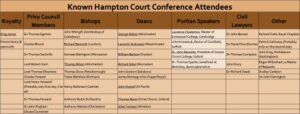
Chart of the known attendees of the Hampton Court conference. Puritan Speakers are highlighted. KJB creators are underlined.
KJB Creators Present At The Conference
-
- King James I
- Bishop of London Richard Bancroft, (later Archbishop of Canterbury)
- Bishop of Winchester Thomas Bilson
- Dean of Winchester George Abbot (later Archbishop of Canterbury)
- Dean of Westminster Lancelot Andrewes
- Dean of Chester William Barlow
- Dean of Worcester Richard Edes
- Dean of St. Paul’s John Overall
- Dean of Christ Church Thomas Ravis
- Dean of Windsor Giles Tomson
- Laurence Chaderton
- Dr. John Rainolds
Major Players
Some major characters are worth noting in more detail. John Whitgift was the archbishop of Canterbury at the time, the highest ecclesiastical office in England apart from the King himself. He played a major role in some important parts of the conference. But as we will see when we walk through the events of the conference, during the second day, when the KJB was proposed, he sent two representatives in his place. He choose instead to meet with the other bishops in order to comply with the king’s orders to settle certain issues among themselves. First was Richard Bancroft, who we will discuss below, and second was bishop of Winchester Thomas Bilson. He would later work as one of the final editors of the King James Bible, probably crafting the para-textual material.
The four Puritan spokesmen, John Rainolds, Laurance Chaderton, John Knewstubs, and Thomas Sparke, spoke for the group which was the precipitating cause of the conference. Rainolds and Chaderton both went on to work as translators in two of the Hebrew Companies of translators (Chadderton at Cambridge on I Chronicles-Song of Songs and Rainolds at Oxford on the Prophets).
Delegates?
How do we rightly think of these men? They are often refereed to as the Puritan “delegates” or “representatives,” but this can in fact be a bit misleading. As this conference was taking place, somewhere not far away, some thirty of the less moderate Puritans were meeting at the same time, who had not been invited to the conference. In one of his earliest treatments of the conference, the veteran historian of Puritanism, Patrick Collinson, explained, “Not a hundred miles from the Privy Chamber at Hampton Court, ‘at the conference but not in place’, there was a gathering of some thirty ministers representing eleven counties and four towns.” (pg. 37-38). These men included Author Hildersham, who, as we have seen, likely drafted the Millenary Petition, Thomas Wilcox, Stephen Egerton, and Henry Jacobs.
They were the ones pressing upon the king for change. They had drawn up a list of instructions for the spokesmen at Hampton Court to follow. Yet, as Collinson concludes, “This robust statement was not adequately expressed, or represented, by the four spokesmen who appeared for the Puritans” at the conference. These men had not even been allowed to decide who would be at the conference to give voice to their concerns. The king and bishops it seems rather most likely made this choice, quite intentionally picking some of the most moderate voices. These “hotter” Puritans (especially Henry Jacobs) later complained that they had not been represented accurately at the conference. As Jacobs put it, “Most of the persons, appointed to speak for the Ministers, were not of their choosing, nor nomination, nor of their judgment in the matters then and now in question, but of a clean contrary.” Yet this was no mistake or oversight; it was likely by design. The four men who voiced Puritan concerns at the conference are thus better thought of as “spokesmen” than as representatives or delegates.
In any case, the two men who really shone at the conference, especially on the second day most relevant to the KJB, were John Rainolds, the leading Puritan spokesman, and Richard Bancroft, the ultimate Anti-Puritan.
John Rainolds
John Rainolds (1549-1607) seems to have been sent to Oxford at the age of eight (though probably he was sent back home shortly). He returned as a student in 1562, first at Merton College, then at Corpus Christi College. He came to Oxford as a Catholic, like his father and much of his family. But over the course of several years, he gradually converted to Protestantism, becoming in the late 60’s a Puritan in every sense of the word, though a moderate one. This was a status held with enough conviction that he was entrusted with tutoring young Richard Hooker, who would go on to become perhaps the most influential theologian of the Church of England. He graduated MA in 1572 and was elected Greek reader at Corpus. His lectures were immensely popular, but he resigned the position in order to devote more time to the study of theology.
He slowly emerged as the face of the Puritan moment at Oxford, getting caught up in a number of controversies along the way. He agitated Queen Elizabeth I on a few occasions, who saw him as a bit too extreme. He labored to refute both the Catholic Bellarmine, arguing against accepting the Apocrypha as Scripture, and the eccentric controversialist Hugh Broughton, with his precise and detailed chronological reading of Scripture. The latter fight followed him for nearly a decade.
In 1598 he was installed as Dean, and then as president, of Corpus Christi, a post he held until his death, greatly increasing the future of Corpus. By the time of the Hampton Court conference, he had become one of the most widely respected Puritan leaders in England. It was only natural then that he would become a kind of informal spokesman for the Puritan cause at the conference. As Mordechai Feingold notes, “Rainolds’s name appeared on every list of puritan candidates that had been circulated the previous summer and autumn. When the historic occasion arrived, it was he who led the puritan delegation.” Feingold goes on to explain that Rainolds, in the midst of controversy after the conference, proceeded,
in what he clearly regarded as the most important project of his career—and the only tangible result of the Hampton Court conference—the new translation of the Bible. The task was divided among six groups, and Rainolds was part of the one charged with translating both major and minor prophets. Although officially headed by John Harding, the regius professor of Hebrew, the group met at Rainolds’s lodgings at Corpus three times a week, a practice that continued even during the last weeks of the president’s life.
Joseph Hall spoke of the towering genius of Rainolds shortly after his death, saying, “He alone was a well furnished library, full of all faculties, full of all studies, of all learning; the memory, the reading of that man, were near to a miracle.”
Richard Bancroft
Richard Bancroft came to Cambridge as a slightly older man than was common in that day, but graduated BA in 1567, and proceeded MA from Jesus College in 1572. Known for his reputation in boxing, wrestling, and other competitive sports, he developed a firm no-nonsense tone that seemed to cross over into his academic work. He was soon ordained priest in the diocese of Ely at the age of thirty. He was admitted DTh at Cambridge in April 1585. He curried royal favor, becoming treasurer of St. Paul’s Cathedral by royal prerogative in 1586, and becoming a canon of Westminster in 1587.
A Famous Sermon
He increasingly became known as the major spokesman for conformity. He waged a battle throughout his career against Catholics on the one hand, and Puritans on the other. In his famous St. Paul’s Cross sermon in 1589, which drew battle lines talked about for decades, he controversially argued against the Puritans that episcopacy (church structure built on bishops, who rule in an administrative capacity over multiple churches and over other lower ministry positions, grouped together into dioceses, under the king as true head of the church) was not only a biblically acceptable model, it had in fact continued since apostolic times with apostolic authority as the only approved model. In that sermon he reacted sharply against the charges of the anonymous Martin Marprelate;
Bishops have had this authority, which Martin condemeth, ever since the evangelist S. Mark’s time. Besides, in the most flourishing time of the church, that ever happened since the apostles’s days, either in respect of learning, or of zeal, Martin and all his companions opinion hath heerin been condemned for an heresy. Lastly, there is no man living, as I suppose, able to show, where there was any church planted ever since the apostle’s times, but there the Bishops had authority over the rest of the ministry.”
[Spelling/punctuation updated slightly in all citations of Bancroft.]
By a striking association, he connected the Puritans with both modern schismatics and ancient heretics, condemning them all alike as those who, “by schism and heresy divided themselves from the church of God, and rent in sunder by their factions the peace thereof.”
Beyond just Martin, Cranfield explains, “Bancroft’s homily had another intended target: those who exalted the word of God to the point that it became the sole authority that, by preaching and prophesyings, threatened the balance within a church that set greater store by the use of sacraments” (pg. 4). These he denounced as false prophets. While some reformers were proposing the principle of Sola Scriptura, arguing that every man – even those not ordained and trained in the church – had a right to read the Scriptures for himself, Bancroft denounced them as missing the Augustinian principle that, “faithful ignorance is better than rash knowledge.” Indeed, “It falleth not within the compass of every man’s understanding to determine and judge in matters of religion…but of those who are well experienced and exercised in them.” As Cranfield insightfully recognizes, Erasmus and Tyndale had hoped the ploughboy in the field would each have the Scriptures to read for themselves. But for Bancroft, such democratized readers would only become, in his words, “the prattling old woman, the doting old man, the brabling sophister.” They think they are understanding Scripture by reading it, but since they do so without the aid of the ordained bishop, they actually, “tear it in pieces, and take upon them to teach it before they have learned it.” He had little interest in such ploughboys reading Scripture for themselves.
A Legacy Of Anti-Puritanism
Bancroft’s ministry was largely marked by the campaign against Puritanism and a related defense of episcopacy. In 1597 Bancroft assumed the role of the Bishop of London, increasing his reach. While he maintained some personal friendships with several of the more moderate Puritans, he was, as Collinson terms it, “the arch Anti-Puritan.”
Nowhere does this become more clear than in his actions and comments at the Hampton Court Conference. He immediately opposed the suggestion for a new translation, and yet, as we will see, was soon placed by the king as head over the entire project of creating it. Alister McGrath suggests that part of the reason for this reversal must have been because he saw the importance of protecting the interests of the Church of England from both Catholics and Puritans. His position of oversight would further allow him the right of limiting the translators in their freedom.
Bancroft had realized that it was better to create a new official translation that he could influence than to have to contend with the authorization of the Geneva Bible. It was decidedly the lesser of two evils. He was in a position to exercise considerable influence over the new Bible, by laying down rules of translation that would ensure that it would be sympathetic to the position and sensitivities of the established Church of England. And finally, he would be in a position to review the final text of the translation, in case it needed any judicious changes before publication.
A final reason that was “significant to his thinking” likely further motivated this reversal. That is, his own career ambitions. As McGrath goes on to explain;
To support the new translation would be to win the royal favor. Whitgift, the ailing archbishop of Canterbury died in February shortly after the conclusion of the Hampton Court Conference. His successor would be appointed from among the present bench of bishops. Bancroft was the front runner for preferment. Yet promotion lay in the king’s gift, precisely because of the royal supremacy that Bancroft so persuasively espoused. From February onward, Bancroft knew that he had no option if he wanted to secure the see of Canterbury. He would have to make sure the king’s new translation project went ahead smoothly—whatever his personal views on the matter.
Bancroft was politically on the rise, with his eye sharply upon the Archbishop’s chair, a role which he likely assumed unofficially behind the scenes even before Whitgift passed. If his plan was to use the new translation to please the king in order to firmly secure his coveted see, it worked. He was formally confirmed as Archbishop of Canterbury on 10 December 1604. He was then able to more thoroughly, “reconstruct the English Church,” from a place of power, in the phrase that shaped Usher’s classic title.
King James VI And I
King James I himself, was, of course, the most important attendee of the conference. He had appointed himself moderator, everything that happened was ultimately centered around him, and all final decisions were his. It was, as Craig terms it in the title of his dissertation, “The King’s Own Conference.” James was in control, in every way someone could be. Fincham explains that, “All in all, this was a singularly unusual conference, dominated by the king who acted, at different times, as prosecutor, witness, judge, and jury, and used the discussions to demonstrate his theological learning and caustic wit” (pg. 3-4).
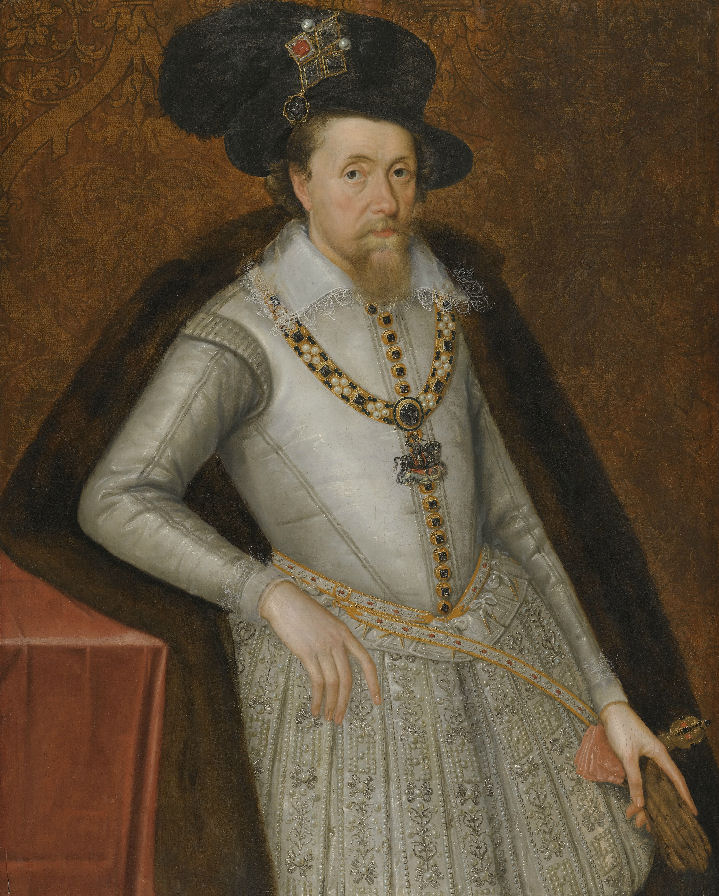
James I, in 1604, wearing the famous “Mirror of Great Britain,” by artist John de Critz. Now at Montacute House.
We have examined already some of the details of the life of James and his rise to the English throne. It suffices here to note that while the circumstance that he came from presbyterian Scotland likely gave the Puritans some hope that they would find favor in his eyes, his actual history fighting the presbyterians in his first kingdom made virtually the exact opposite the case, at least at first. He was as committed to episcopacy as anyone else in the English Church, because of how it bolstered his own ideas of the Divine Right of kings. He was thus less interested in moving the Church in a Puritan direction than he was in dealing with what he saw as a pesky problem that needed a preemptive strike to bring a peaceful resolution. While he would come later to have a more balanced perspective on Puritans and at least some of their demands, they had the misfortune of appearing at the conference, in his eyes at least, to be yet another manifestation of the obstacles to his power raised by presbyterians in Scotland like Andrew Melville. As Jenny Wormald explained (pg. 37), the conference “was held too early in the reign” to produce the positive results the Puritan spokesmen wanted.
James was challenging hardline Elizabethan attitudes too soon for success; and he had not yet fully realized how different from his Scottish presbyterians were the English puritans he met at Hampton Court. Hence his furious and famous outburst, ‘no bishop, no king’; in the heat of debate, he was surely seeing not John Rainolds and his associates, moderate men all, but in response to Rainolds’s unlucky use of the word ‘presbytery’, seeing Andrew Melville and his extremist supporters. Hence his lack of opposition to Bancroft’s extensive deprivations of puritan clerics in 1605–6; deprivation was a weapon he had used in Scotland himself. Nevertheless, Hampton Court was a landmark of importance, in the longer if not the immediate term.
The presence of these three men – James, Rainolds, and Bancroft – at the Hampton Court conference would end up profoundly shaping the final product. The KJB ended up being caught in the middle of an ecclesiastical tug-of-war. Rainolds and the Puritans he spoke for pulled the translation in one direction, representing Puritan interests, while Bancroft, with much more power, pulled it in another, directly opposing those interests and supporting episcopacy. James controlled it all, ensuring that Bancroft had final decisions. It would end up being Bancroft’s Bible, far more than it would Rainolds’s. And that, as we will see, made all the difference in the end.
The Events Of The Conference
But what actually happened at the Conference? What was on the agenda, and whose agenda was it? How did the suggestion of a new translation come about? What did it mean? What was decided? What happened in the “aftermath” of the conference, to use one author’s phrase? And more importantly, how did all of this lead to the creation of the King James Bible?
To these questions we will turn in our next few posts.
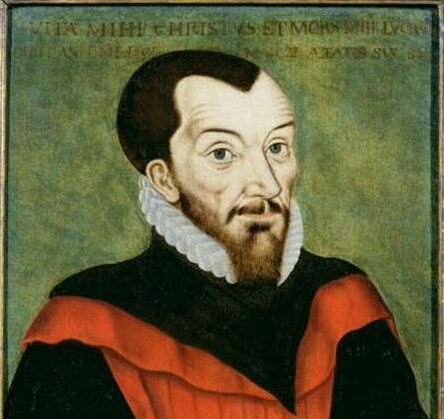
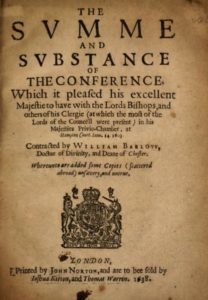


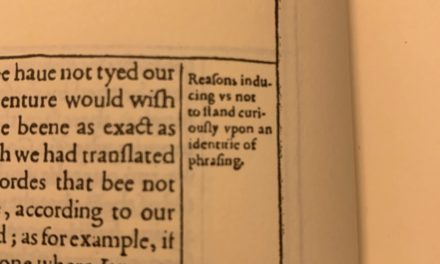
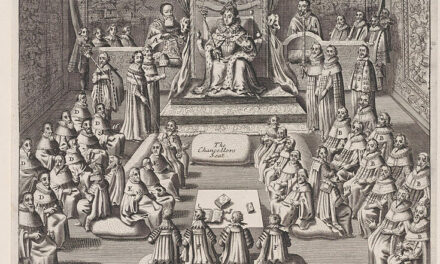
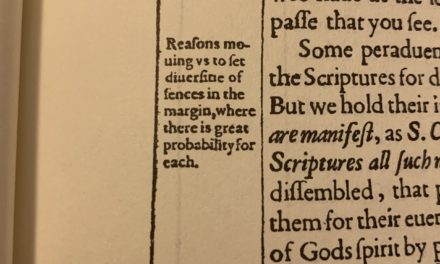
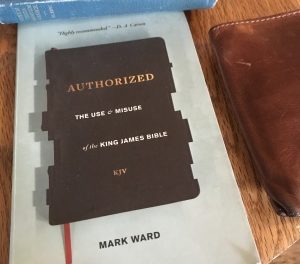
Comments